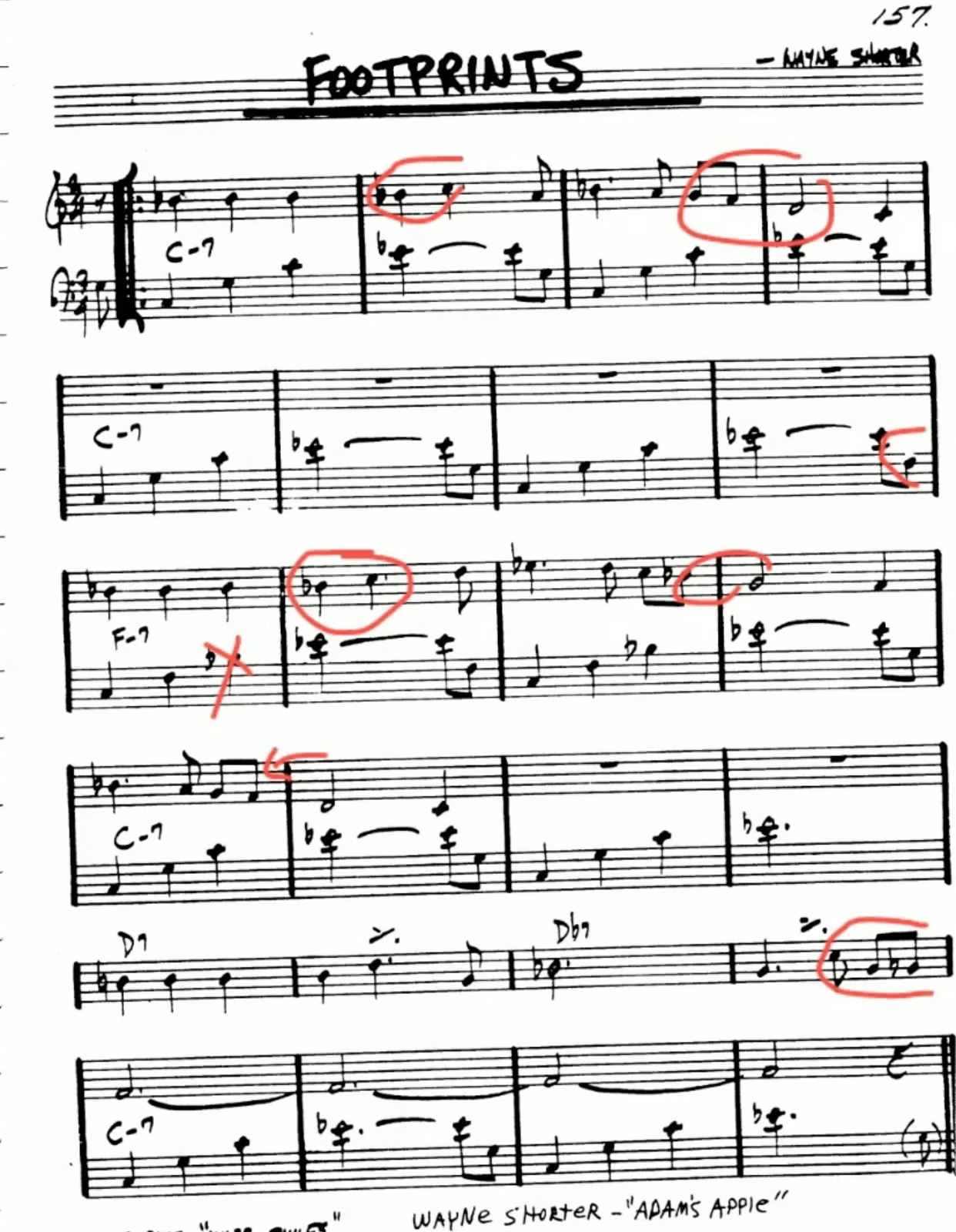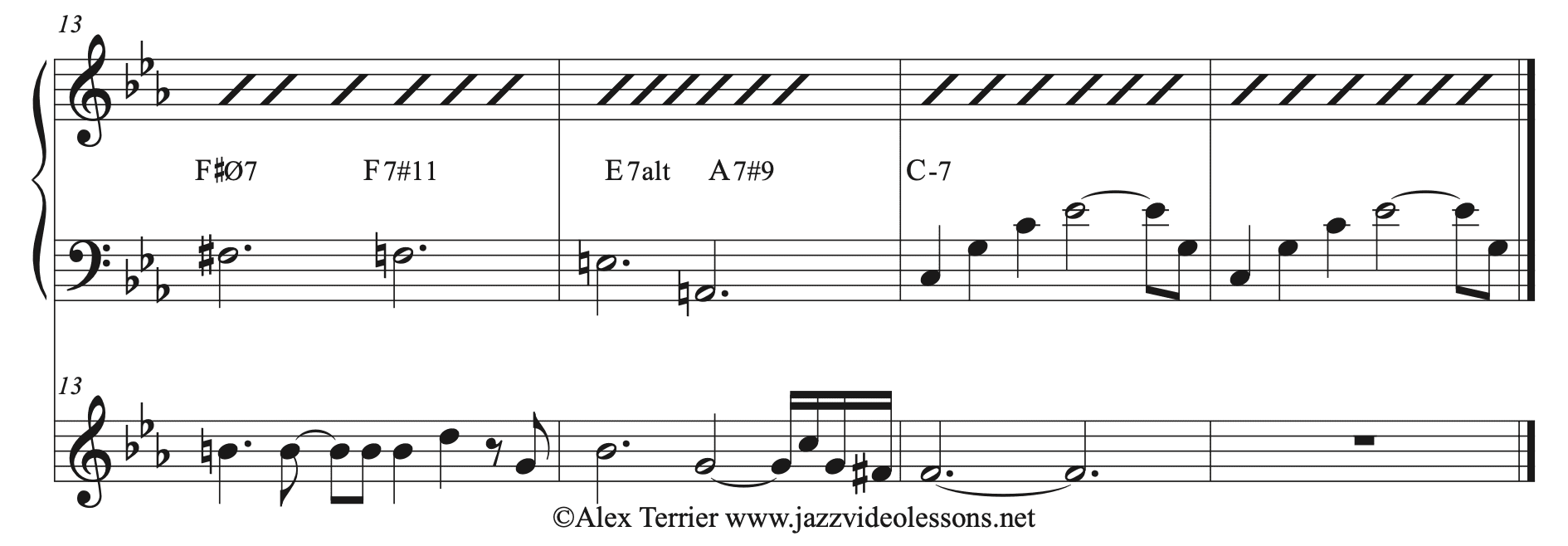Table of Contents
Introduction
Footprints is a jazz standard composed by saxophonist Wayne Shorter and first recorded on his album Adam’s Apple in 1966. The first commercial release of the song was on the Miles Davis album Miles Smiles recorded later in 1966, but released earlier. This song has become part of the core repertoire in jazz education and performance. In this lesson, we’ll examine its structure, harmonic framework, and improvisational techniques.
Whether you play saxophone, guitar, or piano, studying this piece will expand your musical vocabulary and strengthen your approach to group performance.
Footprints - Course
Oops! This content is for members only — unlock it by upgrading your membership and take your jazz journey to the next level!
Oops! This content is for members only — unlock it by upgrading your membership and take your jazz journey to the next level!
Oops! This content is for members only — unlock it by upgrading your membership and take your jazz journey to the next level!
Oops! This content is for members only — unlock it by upgrading your membership and take your jazz journey to the next level!
Oops! This content is for members only — unlock it by upgrading your membership and take your jazz journey to the next level!
Here is what we’ll explore in the course:
- Two distinct modal approaches
- The use of triad pairs
- The pentatonic scales
- Various bebop scale options
- A detailed study of Wayne Shorter’s solo transcription (did you get the quote from A Love Supreme by Coltrane?)
Let’s get started!
Listen to the playlist and let me know in the comments which is your favorite version!
Here is the chart you find in the Real Book with no less than 8 melodic and 4 harmonic mistakes!

This piece is a blues in C minor, clearly structured as a 12-bar form when written in 6/4. A key harmonic feature appears in bars 9 and 10, where the progression—F#ø7 F7#11 | E7alt A7#9—deviates from the D7 | Db7 found in the RealBook.

It is important for the pianist (or the guitarist) to get the accompanying figures right with the anticipation on the “and” of 3:

Quiz
You need to be logged in. Please click here to log in and come back!


12 Responses
Practicing the solo map of Wayne Shorter 🙂
https://vimeo.com/1088448537/c8d8b5e004?share=copy
Next challenge is to play completely alone! Now you are responsible of time as well. Here I play two choruses by myself, again using only the triads pairs.
https://vimeo.com/1080776001?share=copy
I love the challenge of playing with only the drums: I’m fully responsible of not getting lost and being clear with the harmony. Here I am using a Drumgenius track and I also wanted to focus on creating melodic phrases based on the triad pairs we studied in the course.
https://vimeo.com/1080775043?share=copy
Concerning the F7#11 chord, i am skeptical. I think you play a F-7 scale with Ab and Bb. No?
F7#11 scale needs a A and a B natural.
I’d need to know the video and time you are referring to so I can check it out!
The video “Let’s practice together” concerning the mode on Footprints.
When I play the exercise I play correctly the F7#11 with A and B, I tried to spot a mistake maybe when I improvised but couldn’t find any, if you have the timing I’ll check again
From a recent concert: https://vimeo.com/1082194721?share=copy
My prefered version comes with the record “Miles Smiles”. My record is worn out!
I heard this tune too in concert in 1969 by the same musicians. Tony Williams deserves a great job in this version and it
was a great moment in concert.
But I like all the versions especially on the record “Adam’s Apple”.
As usual, some flute Footprints versions (but you can hear Anne Drummon with Kenny Baron in the set list).
Carlo Nicita (trio) https://www.youtube.com/watch?v=RSDn4CABVsc
Mark Weinstein https://www.youtube.com/watch?v=xVofC6U9Zp8
Herbie Mann (Miroslav Vitous Bass) https://www.youtube.com/watch?v=BBvOD9OzNDs
Dave Valentin (the fastest one) https://www.youtube.com/watch?v=EvbcNGaqcJ4
And the thrid part of the study on metric modulations on Footprints https://youtu.be/mSCO3gy7e6E?si=dY2x376lWMQgYYKz
I like all versions…but my favorite is the one in Miles Smiles and the live one in Sweden. And here a very interesting study on the bass lines of Regie Workman and Ron Carter and especially on the metric modulations https://youtu.be/HAwdrHAdYsw?si=w-rWLRtue1kOKOUf and https://youtu.be/CBo6sFB_qBI?si=EMefrz_cwPoqoKml